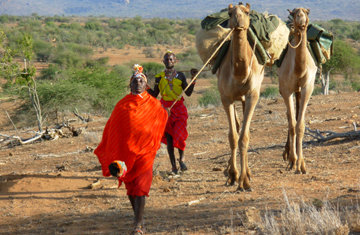
Fancy a ride? Luckily, most of your journey will take place on foot
On the face of it, the camel is hardly a lovely creature. Mark Twain in Innocents Abroad compared it to "an ostrich with an extra set of legs." And yet over five days on safari in northern Kenya, these beasts of burden enabled us to enjoy an exhilarating, almost old-fashioned adventure.
For many travelers to Africa, a safari invariably involves a 4x4 or an overland truck. But a camel safari offers a closer way of connecting with the landscape and its people. You don't actually ride the camels — which, after sitting on one for half an hour, was a blessed relief. Rather, they carry the luggage and provisions, with a mixture of grace and grumpiness, while you trek alongside.
The safari company Karisia, www.karisia.com — run by husband-and-wife team Kerry Glen and Jamie Christian — has been organizing tailor-made expeditions and promoting conservation work in the Laikipia and Samburu regions of central and northwestern Kenya for five years. Christian says the safaris enable them to pursue their passion for conservation. "The idea is to get people to appreciate nature through traveling here and supporting the local communities, so they in turn become inspired to protect the animals and everything around them."
But for the spirited traveler, the safari itself is the key. Our adventure began after our twin-prop touched down at a remote bush landing strip at Kimanjo, deep in Laikipia. From there it was a Land Cruiser ride to our first camp, set beneath acacia and a vast sycamore fig. Here we met the troop in its full glory: 19 camels and 15 Samburu, Turkana and Masai tribesmen. The sense of joining an ancient caravan heading into the bush was heightened by the fact that there would be almost no contact with the outside world for several days.
After a hearty three-course supper, we took to our beds under fly tents in the knowledge that we would be up at 5:30 a.m., before the heat of the day, for our first hike. Woken with a cup of tea and a basin of hot, if muddy, water we set off, following the course of the Ewaso Nyiro river and other lugga (dry riverbeds).
Stunning changes in scenery, from savanna to kopjes (small hills) and rocky ridges, were one of the highlights of the journey, the landscapes all the more forbidding and arid because of the late arrival of the rainy season. Even though wildlife was relatively scarce, we still saw a wealth of fauna including greater kudu, the agile klipspringer antelope, fish eagles, the voracious ant lion and shy pancake tortoises. Added drama came from following elephant tracks, hearing a leopard grunt across a riverbank, speculating as to the whereabouts of a lone crocodile near our camp and scrambling up the rocky 5,000-ft. (1,500 m) massifs of Ngai Sui Sui and Tale, or down the Lengatoi river gorge — memorable for its heavily eroded granite and limestone rocks.
Walking with our guides, and the intimacy this encouraged, meant our knowledge of local tribal customs and habits was also constantly being furthered: we learned from the Samburu about the local form of messaging, which uses a cissus plant and an acacia thorn. The cissus leaf is like a thick, green pad, and you write by making indentations with the acacia thorn, passing on or leaving the leaf somewhere for the recipient. We also learned how the fibrous branches of sokotei tree can be used as an effective toothbrush and toothpick, and heard about the medicinal properties of plants like plectranthus (used for sores and as bee repellent). On a visit to a manyatta (village), two goats were purchased for supper and killed in front of us; we drew the line at joining the crew in drinking the blood.
Yes, there were some creature comforts, from bush showers to sundowners, but the experience of walking and camping with camels was a world away from most safaris, and one that unveiled a very different Kenya. Even Mark Twain would have approved.
